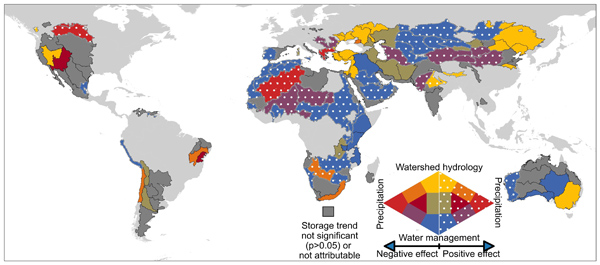Drylands, characterized by an aridity index (AI) below 0.65, cover about 45% of the Earth's land and support over three billion people. Severe water scarcity in these areas poses significant risks to human well-being and ecosystems. However, our understanding of long-term changes in surface water storage and their causes is limited due to insufficient high-quality data with adequate coverage and resolution.
To address these critical issues, a research team from the Institute of Geographic Sciences and Natural Resources Research (IGSNRR) of the Chinese Academy of Sciences (CAS) and their collaborators utilized multi-source remote sensing data to construct a monthly time series of water storage changes for 105,400 lakes and reservoirs in global arid regions from 1985 to 2020. This study was published in Natural Water.
The results revealed that surface water storage in global drylands increased by 2.20 cubic kilometers per year, primarily driven by the construction of new reservoirs. Although natural lakes and old reservoirs did not exhibit significant overall trends, they accounted for the water storage dynamics in 91% of the river basins across arid regions.
Further analysis indicated that long-term changes in the storage of these water bodies were predominantly associated with human activities, including anthropogenic climate warming and water resource management, rather than by precipitation changes, as previously assumed.
This study provides observational data on long-term surface water storage changes in global drylands and attributes these changes to human activities. "The study highlights a decoupling between surface water storage and precipitation in arid regions, posing new challenges to the sustainability of societies and ecosystems," said Prof. ZHAO Gang, first author of the study.
This decoupling underscores the role of global warming and human activities in driving long-term hydrological changes. Consequently, water resource management based solely on precipitation may overestimate or underestimate water availability. Instead, integrated water resource planning should take into account climate, basin characteristics, and human activities to more accurately assess water availability.

The attribution of surface water storage changes to precipitation, watershed hydrology and human water management (Image by ZHAO Gang)






